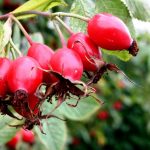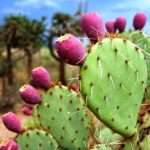By Ken Lain, the mountain gardener
Recent rains have caused an explosion of perennial bloomers to show off in local gardens. There are a number of  perennial plants that are not only pretty but come back year after year for edible goodness. Although Mother’s Day marks the start of gardening for many plants, the edible gardens can go into the ground now.
perennial plants that are not only pretty but come back year after year for edible goodness. Although Mother’s Day marks the start of gardening for many plants, the edible gardens can go into the ground now.
Here are some fun edible perennials that may surprise you. All are in stock at Watters Garden Center.
Bamboo
Panda bears aren’t the only ones who enjoy munching on bamboo shoots. When early shoots arrive in mid-spring, they are tender and delicious. Bamboo grows quickly and prolifically under the right conditions, so you can grow as much or as little as you’d like. I like to grow bamboo in a container on the back deck. It’s beautiful and delicious.
Daylily
The classic lily is a mainstay of any garden, usually considered an ornamental contribution. The brightly-colored flowers bloom on top of stalks that can be up to three feet tall, with floppy leaves circling the base. But did you know that a lily is edible? Enjoy the shoots, some of the spring tubers, the flower buds, and the blossoms.
Dahlia
The dahlia is one of the more unique flowers. Varieties with two-tone petals look like one flower was snapped onto another! Dahlias are small and grow in compact spaces, stand no more than a foot high, and fit well into spicy container gardens. When it’s time to eat, though, the small tubers that dahlias produce are as unique as the blooms. Experiment with different varieties for their different flavors.
Roses
While roses are pretty to look at and sweet to smell, they also can be delicious to taste. Used in many Middle Eastern and Indian cuisines, roses make sweet, floral preserves and vibrant garnishes. This link from Mother Earth News has 12 recipes for using rose leaves, hips, and flowers.
Hosta
One of the most classic garden plants, hostas are an easy to grow perennial with a wide range of varieties. (I like to use hostas with variegated leaves to brighten a shade garden.) Hostas are edible, especially the young shoots which you can break off from the clumps in the center of the plant. There is some debate as to whether all species are edible, but the ‘Sagae’ variety was originally used as an edible and is a good variety for a starter.
Elderberry
Grown for its textured foliage, lovely summer flowers, and deep purple fruits, elderberry is a large perennial shrub. Flowers and berries are edible, though the berries do need to be cooked sufficiently to prevent tummy upset. Jams, jellies, syrups, and herbal remedies are all favorites to make from elderberry. Birds are drawn to elderberry shrubs as much as we are, which is excellent if you are interested in attracting birds as beneficial garden helpers.
Prickly Pear
At first glance, this cactus is intimidating to use because of its tiny spines, but they are easily scraped off with a knife. The pads are cooked and used over meat and fish. Prickly Pear Pad Recipes. The plum-shaped fruits, called Indian figs or prickly pears, ripen in late September. The outsides become bright red and the insides turn a fiery orange. They make a fine syrup, preserves, and jellies. In some parts of Mexico, the fruits are fermented to produce a heady liquor.
knife. The pads are cooked and used over meat and fish. Prickly Pear Pad Recipes. The plum-shaped fruits, called Indian figs or prickly pears, ripen in late September. The outsides become bright red and the insides turn a fiery orange. They make a fine syrup, preserves, and jellies. In some parts of Mexico, the fruits are fermented to produce a heady liquor.
Sweetberry Honeysuckle
A honeysuckle will quickly cover a wall or fence with a cascade of color and fragrance. It’s an abundant source of edible blossoms, and as an extra surprise, the blue-berried variety actually produces a blueberry like fruit! Grow honeysuckle where you can water it well while it establishes and then keep its fast-growing, invasive tendencies under control.
Lady’s Leek
Lady’s leek, part of the garlic family, is grown as an ornamental for its bright bursts of small flowers. It is easy to grow in a well-drained bed. Use the delicate flowers, onion-like stalks, or garlic-like bulbs in your edible garden recipes.
Banana Yucca – This local native grows wild at all elevations of Arizona. Flowers (petals only) and fruit are edible. Other parts of the plant contain saponin, which is poisonous. Large amounts of saponin may be harmful which is why javelins leave this spiky plant alone. The flowers however, have a crunchy, fresh flavor.
Complete Guide to Local Edible Flowers
Perennials to Avoid – There are some flowers that should not be eaten. These are the recognizable locals but is not a complete list: azalea, crocus, daffodil, foxglove, oleander, rhododendron, jack-in-the-pulpit, lily of the valley, and wisteria.
Local Vegetable planting calendar the Works.
Next Gardening Class is April 29 @ 9:30 am- Grow Your Own Groceries
This fun-filled class touches on almost everything edible for the spring garden. We will cover the best varieties of heirloom varieties to local favorites. The ideal soil preparation, best foods, and care are all presented in this fast-paced class. It’s the start of planting season, and this class offers smarter and wiser tips to local ways in the garden. The nursery is loaded with 100’s of non-GMO vegetable starts and organic herbs this weekend. We’re ready to plant!
Until next week, enjoy this perfect planting weather.
Ken Lain can be found throughout the week at Watters Garden Center, 1815 W. Iron Springs Rd in Prescott, or contacted through his web site at WattersGardenCenter.com or FB.com/WattersGardenCenter .

